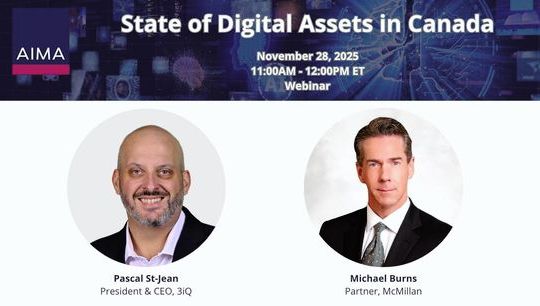Tokenised money market funds: The digital revolution of cash management
By Aditya Sharma; Sumit Sharma; Rajat Jain, NAV Fund Services
Published: 24 November 2025
Money market funds (MMFs) have long been the unassuming backbone of the financial world—low-risk, cash-like vehicles essential for corporate treasurers and individual investors alike. While not typically a glamorous topic, the recent era of higher interest rates has thrust them into the spotlight, revealing both their value and their limitations.
Today, a paradigm shift is underway. The intersection of finance and blockchain technology is giving rise to tokenised money market funds, an innovation poised to address the inherent inefficiencies of traditional MMFs while unlocking a new era of accessibility, efficiency, and utility. This isn’t just an upgrade, it’s a fundamental reimagining of what a money market fund can be.
The tokenisation revolution: What are tokenised MMFs?
Tokenisation is the process of converting an asset into a digital token on a blockchain. A tokenised money market funds is a digital representation of a share in a traditional MMF on a distributed ledger.
In essence, each token is a unit of ownership in the fund, combining the established stability of a conventional MMF with the transformative power of blockchain technology. It’s not about changing the underlying assets; it’s about radically improving the wrapper they come in and what you can do with it.
Market momentum: A multi-billion dollar surge
The tokenised money market fund (MMF) segment has quickly become the growth engine of real-world asset (RWA) tokenisation. As of August 2025, tokenised Treasury and MMF assets stand at US$7.4 billion, marking an 80% year-to-date increase and demonstrating strong institutional appetite for efficiency and liquidity.
Key benefits of investing in a tokenised money market funds
- Enhanced liquidity and 24/7 markets: Unlike traditional MMFs confined to market hours, tokenised versions can be traded 24/7/365 on digital platforms. This provides unparalleled flexibility for global investors operating in different time zones. In addition to the direct liquidity there are liquidity options through the DeFi protocols such as Automated market makers, lending protocols etc.
Secondary markets are another option where investors can liquidate to other peers via an ATS.2 - Fractional ownership: Tokenisation shatters high minimum investment barriers. Investors can own fractions of a share, making these once-institutional products accessible to a much broader retail audience.
- Faster settlement and redemption: Blockchain enables near-instant settlement of transactions, eliminating the 24-hour+ wait for redemption proceeds. Some platforms even offer instant redemption tools, providing real-time access to cash. Transaction costs are also improved in comparison.
- Transparent operations: Every transaction is recorded on an immutable public ledger. Investors can independently verify the fund’s Net Asset Value (NAV) through oracle networks and confirm their holdings via proof-of-reserves, eliminating opacity.
- New financial utility: Perhaps the most exciting benefit is the emergence of new use cases:
- Collateral: Major crypto brokers (e.g., FalconX, Hidden Road, BitGo) now accept tokenised MMFs as collateral for trading. - DeFi integration: These tokens can be used as yield-bearing collateral in decentralised finance (DeFi) lending protocols, unlocking innovative yield-generation strategies.
- Efficient transfers: Transferring ownership between investors can be done in minutes, not weeks, without cumbersome paperwork.
Key considerations when thinking about starting a tokenised funds
The technical foundation: How it works
Blockchain protocols: Choices range from public networks like Ethereum to permissioned ledgers like JPMorgan’s Onyx or Hyperledger Fabric, which offer more control and privacy for institutions.
Smart contracts: These self-executing contracts automate critical functions: issuing shares, distributing dividends, enforcing transfer restrictions (e.g., only allowing whitelisted investors to trade), and processing redemptions.
Oracles: Services that feed real-world data (like the daily NAV of the fund) onto the blockchain so the smart contracts can operate accurately.
Secure custody: Solutions involving multi-signature wallets and qualified custodians to hold the underlying assets and manage the token minting/burning process.
Regulatory & compliance considerations in tokenised MMFs
Tokenised money market funds face a unique regulatory challenge, they must uphold the strict liquidity, transparency, and investor protection rules of traditional MMFs while operating in a borderless, 24/7 digital environment.
Smart contracts now enable more efficient AML/KYC processes, automating investor whitelisting and creating immutable audit trails. Still, administrators must carefully balance blockchain transparency with data privacy regulations like GDPR.
Globally, regulators are stepping up. The U.S. GENIUS Act has provided much-needed clarity, creating a favorable environment for tokenised MMFs by banning yield-bearing stablecoins—which removes a key competitor—and encouraging institutions to tokenise traditional assets like MMFs within a clear compliance framework. This is complemented by other US legislative efforts, such as the Digital Asset Market Structure Bill, which seeks to clarify jurisdiction between the SEC and CFTC, and the CLARITY Act, which aims to provide exemptions for certain digital assets, collectively reducing regulatory ambiguity.
Meanwhile, Hong Kong’s SFC recently introduced tailored licensing codes (Aug 2025) that set strict custody, disclosure, and risk management standards—initially for professional investors. In Europe, the MiCA regulation is advancing, classifying tokenised funds as crypto-assets subject to rigorous compliance.
Beyond these major economies, pivotal fund jurisdictions like the Cayman Islands are also adapting. Following a consultation that ended in September 2025, the Cayman Islands has presented amendment bills to its Private Funds and Mutual Funds Acts. These changes, expected to be implemented in early 2026, are designed to explicitly cover tokenized funds, introducing definitions for digital tokens and addressing custody, recordkeeping, and cybersecurity for these new structures.
The role of fund administrator in tokenised money market funds
In tokenised money market funds (MMFs), the fund administrator moves from being a back-office function to a critical operational partner, ensuring stability, compliance, and investor confidence in a digitally transformed environment. MMFs prioritise liquidity, capital preservation, and daily NAV calculations, making precise administration essential. They calculate NAV daily and in real time, monitor liquidity and cash flows in short-term debt instruments such as Treasury bills, and manage compliance including AML and KYC checks that are more complex in tokenised funds.
Investor services such as portals, communication, and yield distribution, help maintain trust. For tokenised MMFs, administrators integrate blockchain technology to automate reconciliations, enable instant settlements, and provide real-time transparency through smart contracts.
Conclusion: The democratisation of finance is here
Tokenised money market funds represent more than a tech advancement; they are the innovator of a broader movement to make finance more efficient, accessible, and transparent. By bridging the trusted world of traditional finance with the innovative potential of blockchain, they offer the best of both worlds: stability and progress.
The flow of capital into these funds is a powerful market signal. While regulatory and technical challenges remain, the direction is clear. The future of cash management is digital, programmable, and on-chain. The question for institutions is no longer *if* but *when* and *how* they will participate in this digital transformation.
For more information, please visit NAV Fund Services.





